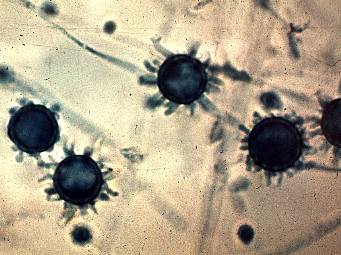
 This month's fungus is a dimorphic pathogen that causes a disease called histoplasmosis, also known as Darling's disease, reticuloendotheliosis, reticuloendothelial cytomycosis, Ohio Valley disease, tingo, and Maria fever. It is actually a very common disease in the Ohio and lower Mississippi River Valleys, but rarely causes severe disease.
This month's fungus is a dimorphic pathogen that causes a disease called histoplasmosis, also known as Darling's disease, reticuloendotheliosis, reticuloendothelial cytomycosis, Ohio Valley disease, tingo, and Maria fever. It is actually a very common disease in the Ohio and lower Mississippi River Valleys, but rarely causes severe disease.
